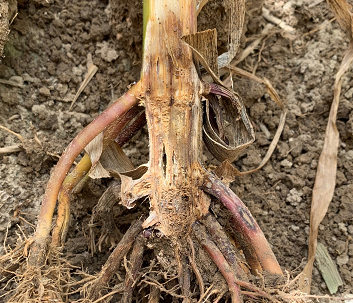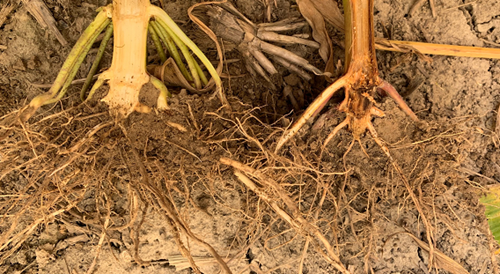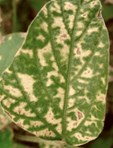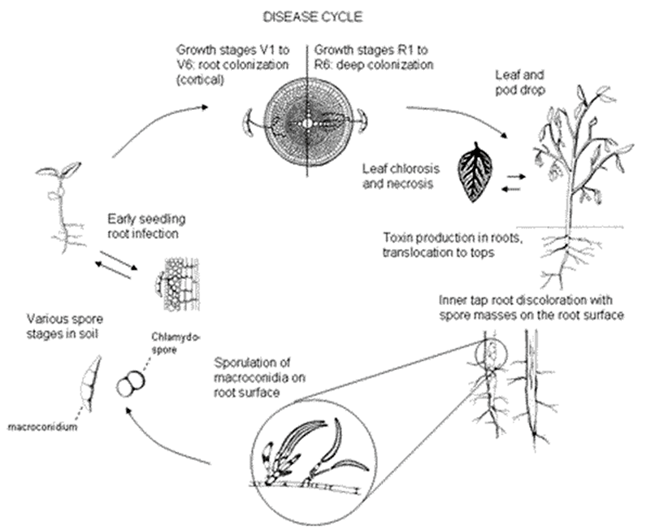Agronomy Update: Pre-Harvest Scouting and Planning
BY DAIRYLAND SEED AGRONOMY TEAM
Crown and Stalk rots and the importance of scheduling harvest order
With corn harvest soon upon us it is especially important this year that we spend time scouting our corn fields and prioritizing which fields need to be harvested first and which ones can wait. In walking corn fields, we are seeing crown and stalk rots already having an effect on plant health, as well as standability. The photo below shows a corn plant with Fusarium that has both crown and stalk rot.

In most situations the reasons we are seeing more crown and stalk rots this year compared to other years, is being forced to plant in “less than ideal conditions” which forced many corn plants to be subjected to cool or cold water early in its growth cycle. Sidewall compaction, fertility deficiencies as well as cool wet soils increase the incidence of crown and stalk diseases.
The disease that I believe most prevalent this year will be Fusarium. Other diseases that I anticipate seeing due to our cooler wetter growing season will be:
- Anthracnose which is mainly thought of as top dieback disease but the more advanced stages of the disease show black lesions on the stalk
- Physoderma Brown Spot which in most instances is a leaf disease but can cause stalks rots that is associated with a brown or black ring around one or several of the lower nodes on the stalk
- Diplodia Stalk Rot can be found in both the stalk and the ear or kernels with stalks and kernels a rough texture it tends to cause affected tissue to have black fungal formations on it
- Gibberella Stalk Rot which is very similar in appearance to Fusarium and is tough to discern which one it is due to both cause pink/red or salmon colors inside the stalk
The procedure that I follow to check fields is to review which fields were planted in “less than ideal conditions” as well shorter day hybrids and scout them first. I will then walk across a portion of the field and perform Pinch, Push, Shove and Slash tests along the way looking at both green healthy plants and also plants that are yellow/tan and or stunted:
- Pinch the stalks 4-8” off the soil level if it collapses you have a crown or stalk rot, or both
- Push the stalks so the top of the plant touches the row across from it, if it buckles under that pressure odds are you have a stalk rot
- Shove a few stalks down the row and see how much pressure it takes to break them, the less pressure it takes to break them increases the probability of standability issues
- Slash or cut the stalk 10-12” above the soil line with a sharp knife down to or through the roots, (remember to be safe and cut away from yourself) I generally will dig the plant first. The crown and stalk should be a white or creamy color, (the photo below shows a healthy stalk and root on the left, whereas, the stalk and root on the right is not healthy) if it is not that plant has a crown or stalk rot

The more plants that fail these tests increases the odds that you will need to harvest that field early or move it up in the harvest schedule. Remember that these affected plants will be more susceptible to wind damage the longer the harvest window gets.
Having and following a harvest order decreases the likelihood of harvesting down corn, and increases the likelihood of capturing more yield but also having a safer and less stressful harvest season.
Corn Silage Harvest Timing
Timing is everything! For livestock producers, silage harvest timing is one of the most important decisions, impacting feed quality for the entire year. The key trade-off with silage moisture is high fiber digestibility and low starch in wet silage OR low fiber digestibility and high starch in dry silage. After the weather cleared during 2018’s wet September, many of us harvested silage that was too dry and quickly learned that its more difficult to add fiber digestibility to dry silage than it is to add starchy grain to a wet silage!
Target 50% milkline, right? Well, not exactly. Milkline is like holding your finger in the air to judge windspeed when you really need a weather station. Holding your finger in the air works, but do you feel confident that it will steer your operation in the right direction for the year? Whole plant moisture is much better, since ear and whole plant development vary between hybrids and environments. Here’s what you should do:
- Determine an average moisture target: 68% moisture is generally the sweet spot, especially if you store in a bag or bunker. Silos can go to the mid to low 60’s and you may want to adjust your target based on your ration needs (starch vs digestibility).
- Measure current whole plant moisture: Select representative plants from your field after kernel dent, chop them soon after cutting and measure moisture using an NIR or oven drying method.
- Project a start date: corn dries in the field at a rate of about 0.5% moisture per day in September, faster in hot weather. Factor in the time required to harvest and plan to start harvesting before the crop reaches your average moisture target and finish shortly after drying past it. Many scenarios require us to start harvesting when moistures are in the low 70’s to avoid silage that is too dry by the time we finish.
SDS in 2019
| Reports of the “leaf scorch” phase of the ubiquitous Fusarium pathogen that initiates Sudden Death Syndrome (SDS) in soybean fields are being received. The onset of this disease infects the root system very early in the season during germination and soybean emergence. As the season progresses, the leaf symptoms become evident in the canopy as small pale green to yellow spots that expand within the leaf tissue leaving the veins somewhat green. As the disease advances, areas between the veins become necrotic and may completely fall from the plant leaving the petioles attached to the stem. Leaf symptoms are really just the manifestation of the toxin build up within the plant as the vascular system becomes polluted restricting moisture flow within the plant. |  |
Root system symptoms become evident by large amounts of discolored root tissue and crown rot that can sometimes be evidenced by a bluish mold on the exterior of the tap root of the plant. Often times, roots can be very easily pulled out of the ground as large portions of the lateral root system has rotted away. This year has provided almost perfect conditions to serve up the ability for SDS to rear its ugly head. Below are some management aspects to keep in mind for the future mitigation of this yield robber.
- Utilize effective seed treatment products on high quality seed
- Use high yielding SDS tolerant varieties…no known resistance at this point
- Manage SCN (SDS and SCN are often “fast friends”)
- Plant early with a favorable future weather forecast, or in warmer dryer soils
- Manage soil compaction and improve drainage
- Track fields with a known history of SDS
- Minimize the inoculum
- Rotate crops
- Avoid beans on beans
- Harvest corn effectively….large amounts of kernel loss can be problematic for increasing incidence of SDS
SDS can often be mistaken for other similar looking soybean diseases such as Brown Stem Rot and Stem Canker, so here are a few items to note as you investigate.
- SDS will have both leaf and root system symptoms but even around rotted stem tissue the pith of the stem will remain white. In addition, the petioles of the leaf will typically remain attached to the stem. When the stem is cut diagonally the vascular tissue, not the pith, will have blotchy dark areas visible.
- Brown Stem Rot may have very similar leaf symptomology but petioles tend to drop away from the stem, while the pith of the stem will have a distinct brown hue. In some instances, there may not even be any leaf symptomology only stem.
- Stem Canker will have a dark brown sunken area girdling to stalk and will become extremely brittle.

SDS disease cycle. Credit: Purdue University https://soybeanresearchinfo.com/diseases/suddendeathsyndrome.html
 |
 |
 |
 |
 |
| Brian Weller Western Region 507.456.3034 |
Dan Ritter Central Region 219.863.0583 |
Branden Furseth Northern Region 608.513.4265 |
Rod King Eastern Region 574.596.6721 |
Terry Jones Eastern Region 419.630.3115 |
